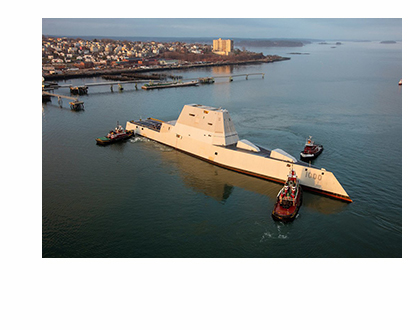The U.S. Navy’s newest destroyer did something amazing this week: It floated.
As absurd as it sounds, it was worth finding out whether this $4-billion-plus boondoggle is at least a seaworthy boondoggle. And at least there won’t be 32 of these ships, which was the Pentagon’s previous plan. Now that Bath Iron Works has built the Zumwalt — and assuming it won’t tip over in bad weather, which is a worry — the military will use it to test new techniques and technologies.
A priority should be using this expensive experiment on this Maine shipyard-built ship to save money on the next-generation large warship, which probably will enter the fleet in the mid-2030s.
One efficiency of the new ship comes from crew: With just 160 or so sailors, the Zumwalt needs about half the bodies of the standard destroyer. Tasks such as loading cargo and firefighting will be fully automated, saving $600 million over the lifetime of the ship. The Navy also says the ship’s Linux-based computer system is less expensive to update and more efficient, allowing crew members to monitor operations and communicate with one another from anywhere in the vessel, as opposed to a single operations room.
The most innovative money-saver comes from munitions, an often-overlooked expense. Tomahawk cruise missiles cost roughly $1.5 million each. The Zumwalt class — assuming the Pentagon can get the technology right — will be fitted with an electromagnetic rail gun capable of launching projectiles at seven times the speed of sound as far as 100 miles. Each nonexplosive projectile costs just $25,000. (The ship also will have a more traditional vertical gun system.)
For defense, the Zumwalt will depend on its hull design — it is said to register on radar as a vessel the size of a fishing boat — and an array of laser weapons now being tested in the Persian Gulf.
What all this science-fiction stuff requires is a lot of energy. While considered a destroyer, the Zumwalt is bigger than a standard cruiser (the next class up) and has much in common with an old-fashioned battleship. The size is necessary to accommodate the massive Rolls-Royce gas turbines that help it produce 58 megawatts of reserve power for battle, six times that of the current class of destroyers and enough to power a city of about 100,000 people.
Of course, there is a good case that these capabilities should have been tested on existing craft before General Dynamics was given the green light to start building. The Navy made a huge mistake in commissioning 32 of the new littoral combat ships before sufficiently testing their innovative modular system, and they have been plagued by cost overruns and technical setbacks at every turn.
In the end, the Navy ordered three Zumwalt-class cruisers, which may be two too many. But at least for once, the Pentagon knew to cut its losses. Now it’s up to the Navy to prove that by spending billions, it can save even more.
Editorial by Bloomberg View
Send questions/comments to the editors.




Success. Please wait for the page to reload. If the page does not reload within 5 seconds, please refresh the page.
Enter your email and password to access comments.
Hi, to comment on stories you must . This profile is in addition to your subscription and website login.
Already have a commenting profile? .
Invalid username/password.
Please check your email to confirm and complete your registration.
Only subscribers are eligible to post comments. Please subscribe or login first for digital access. Here’s why.
Use the form below to reset your password. When you've submitted your account email, we will send an email with a reset code.